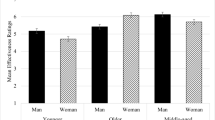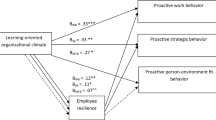Abstract
While there is burgeoning interest in proactive behavior in today’s workplaces, very little is known about cognitive mechanisms by which employees engage in proactive behavior. Drawing on the theory of planned behavior (TPB), we explored critical antecedents and cognitive mechanisms of proactive behavior in Asian work contexts. The results of structural equation modeling analyses conducted for 138 supervisor-subordinate dyads in Korean firms supported most of the propositions of the TPB. Learning goal orientation was found to be associated with proactive behavior through attitudes toward proactive behavior. Perceived organizational support was related to proactive behavior through the intervening mechanisms of subjective norms and intention. Job autonomy predicted proactive behavior through the mediating processes of perceived behavioral control and intention. These findings have meaningful implications for the literature on proactive behavior.



Similar content being viewed by others
Notes
As data for proactive behavior were obtained from a different source (i.e., supervisor ratings), items of proactive behavior were excluded from the EFA. We were unable to perform a confirmatory factor analysis due to small sample size.
Because data were nested within firms, we checked intraclass correlation coefficient (ICC)(1) values for the study variables, as recommended by Bliese (2000). The ICC(1) values for the variables were sufficiently low, suggesting that non-independence was not a serious issue in our data.
References
Ajzen, I. 1991. The theory of planned behavior. Organizational Behavior and Human Decision Processes, 50(2): 179–211.
Ajzen, I. 2002. Constructing a TPB questionnaire: Conceptual and methodological considerations. http://www.people.mass.edu/ajzen/tpb.html.
Axtell, C. M., Holman, D. J., Unsworth, K. L., Wall, T. D., Waterson, P. E., & Harrington, E. 2000. Shop floor innovation: Facilitating suggestion and implementation of ideas. Journal of Occupational and Organizational Psychology, 73: 265–285.
Bandura, A. 1977. Self-efficacy: Toward a unifying theory of behavioral change. Psychological Review, 84(2): 191–215.
Bandura, A. 1982. Self-efficacy mechanism in human agency. American Psychologist, 37: 122–147.
Bateman, T. S., & Crant, J. M. 1993. The proactive component of organizational behavior: A measure and correlates. Journal of Organizational Behavior, 14(2): 103–118.
Becker, T. E. 2005. Potential problems in the statistical control of variables in organizational research: A qualitative analysis with recommendations. Organizational Research Methods, 8: 274–289.
Bliese, P. D. 2000. Within-group agreement, non-independence, and reliability: Implications for data aggregation and analysis. In K. J. Klein & S. W. J. Kozlowski (Eds.). Multilevel theory, research, and methods in organizations: Foundations, extensions, and new directions: 349–381. San Francisco: Jossey-Bass.
Bollen, K. A. 1989. Structural equations with latent variables. New York: Wiley.
Brislin, R. W. 1986. The wording and translation of research instruments. In W. J. Lonner & J. W. Berry (Eds.). Field methods in cross-cultural research: 137–164. Newbury Park, CA: Sage.
Button, S. B., Mathieu, J. E., & Zajac, D. M. 1996. Goal orientation in organizational research: A conceptual and empirical foundation. Organizational Behavior and Human Decision Processes, 67(1): 26–48.
Chiaburu, D. S., Marinova, S. V., & Lim, A. S. 2007. Helping and proactive extra-role behaviors: The influence of motives, goal orientation, and social context. Personality and Individual Differences, 43: 2282–2293.
Crant, J. M. 2000. Proactive behavior in organizations. Journal of management, 26(3): 435–462.
De Stobbeleir, K. E. M., Ashford, S. J., & de Luque, M. F. S. 2010. Proactivity with image in mind: How employee and manager characteristics affect evaluations of proactive behaviors. Journal of Occupational and Organizational Psychology, 83: 347–369.
Dikkers, J. S. E., Jansen, P. G. W., de Lange, A. H., Vinkenburg, C. J., & Kooji, D. 2010. Proactivity, job characteristics, and engagement: A longitudinal study. Career Development International, 15(1): 59–77.
Dweck, C. S. 1986. Motivational processes affecting learning. American Psychologist, 41(10): 1040–1048.
Dweck, C. S., & Leggett, E. L. 1988. A social-cognitive approach to motivation and personality. Psychological Review, 95: 256–273.
Edmondson, A. 1999. Psychological safety and learning behavior in work teams. Administrative Science Quarterly, 44(2): 350–383.
Eisenberger, R., Huntington, R., Hutchison, S., & Sowa, D. 1986. Perceived organizational support. Journal of Applied Psychology, 71(3): 500–507.
Elliot, E. S., & Dweck, C. S. 1998. Goals: An approach to motivation and achievement. Journal of Personality and Social Psychology, 54: 5–12.
Endler, N. S., & Magnusson, D. 1976. Personality and person by situation interactions. In N. S. Endler & D. Magnusson (Eds.). Interactional psychology and personality. New York: Hemisphere.
Frese, M., Kring, W., Soose, A., & Zempel, J. 1996. Personal initiative at work: Differences between East and West Germany. Academy of Management Journal, 39(1): 37–63.
Gibson, C. B. 1999. Do they do what they believe they can? Group efficacy and group effectiveness across tasks and cultures. Academy of Management Journal, 42: 138–152.
Grant, A. M., & Ashford, S. J. 2008. The dynamics of proactivity at work. Research in Organizational Behavior, 28: 3–34.
Griffin, M. A., Neal, A., & Parker, S. K. 2007. A new model of work role performance: Positive behavior in uncertain and interdependent contexts. Academy of Management Journal, 50(2): 327–347.
Hackman, J. R., & Oldham, G. R. 1976. Motivation through the design of work: Test of a theory. Organizational Behavior and Human Performance, 16(2): 250–279.
Hackman, J. R., & Oldham, G. R. 1980. Work redesign. Reading, MA: Addison-Wesley.
Hirschi, A., Lee, B., Porfeli, E. J., & Vondracek, F. W. 2013. Proactive motivation and engagement in career behaviors: Investigating direct, mediated, and moderated effects. Journal of Vocational Behavior, 83: 31–40.
Janssen, O., & Huang, X. 2008. Us and me: Team identification and individual differentiation as complementary drivers of team members’ citizenship and creative behaviors. Journal of Management, 34(1): 69–88.
Joo, B., Song, J. H., Lim, D. H., & Yoon, S. W. 2012. Team creativity: The effects of perceived learning culture, development feedback and team cohesion. International Journal of Training and Development, 16: 77–91.
Kahn, W. A. 1990. Psychological conditions of personal engagement and disengagement at work. Academy of Management Journal, 33(4): 692–724.
Kelloway, E. K. 1996. Common practices in structural equation modeling. In C. L. Cooper & I. T. Robertson (Eds.). International review of industrial and organizational psychology: 141–180. Chichester: Wiley.
Kelloway, E. K. 1998. Using LISREL for structural equation modeling: A researcher’s guide. Thousand Oaks: Sage.
Kim, T., Hon, A. H. Y., & Crant, J. M. 2009. Proactive personality, employee creativity, and newcomer outcomes: A longitudinal study. Journal of Business and Psychology, 24: 93–193.
Kim, T., Hon, A. H. Y., & Lee, D. 2010a. Proactive personality and employee creativity: The effects of job creativity requirement and supervisor support for creativity. Creativity Research Journal, 22(1): 37–45.
Kim, Y., Chiu, C., Peng, S., Cai, H., & Tov, W. 2010b. Explaining East–West differences in the likelihood of making favorable self-evaluations: The role of evaluation apprehension and directness of expression. Journal of Cross-Cultural Psychology, 41(1): 62–75.
Liang, J., Lawrence, R. H., Bennett, J. M., & Whitelaw, N. A. 1990. Appropriateness of composites in structural equation models. Journal of Gerontology, 45(2): 552–559.
Liao, H., Liu, D., & Loi, R. 2010. Looking at both sides of the social exchange coin: A social cognitive perspective on the joint effects of relationship quality and differentiation on creativity. Academy of Management Journal, 53: 1090–1109.
MacKinnon, D. P., Fairchild, A. J., & Fritz, M. S. 2007. Mediation analysis. Annual Review of Psychology, 58: 593–614.
Morgeson, F. P., & Humphrey, S. E. 2006. The Work Design Questionnaire (WDQ): Developing and validating a comprehensive measure for assessing job design and the nature of work. Journal of Applied Psychology, 90: 399–406.
Morrison, E. W., & Phelps, C. C. 1999. Taking charge at work: Extra-role efforts to initiate workplace change. Academy of Management Journal, 42: 403–419.
Nevitt, J., & Hancock, G. R. 2004. Evaluating small sample approaches for model test statistics in structural equation modeling. Multivariate Behavioral Research, 39: 439–478.
Ohly, S., & Fritz, C. 2010. Work characteristics, challenge appraisal, creativity, and proactive behavior: A multi-level study. Journal of Organizational Behavior, 31: 543–565.
Parker, S. K. 1998. Role breadth self-efficacy: Relationship with work enrichment and other organizational practices. Journal of Applied Psychology, 83: 835–852.
Parker, S. K., & Sprigg, C. A. 1999. Minimizing strain and maximizing learning: The role of job demands, job control, and proactive personality. Journal of Applied Psychology, 84(6): 925–939.
Parker, S. K., Williams, H. M., & Turner, N. 2006. Modeling the antecedents of proactive behavior at work. Journal of Applied Psychology, 91(3): 636–652.
Podsakoff, P. M., MacKenzie, S. B., Lee, J., & Podsakoff, N. P. 2003. Common method biases in behavioral research: A critical review of the literature and recommended remedies. Journal of Applied Psychology, 88(5): 879–903.
Porter, L. W., & Steers, R. M. 1973. Organizational, work, and personal factors in employee turnover and absenteeism. Psychological Bulletin, 80(2): 151–176.
Rich, B. L., Lepine, J. A., & Crawford, E. R. 2010. Job engagement: Antecedents and effects on job performance. Academy of Management Journal, 53(3): 617–635.
Seppälä, T., Lipponen, J., Bardi, A., & Pirttilä-Backman, A. M. 2012. Change-oriented organizational citizenship behavior: An interactive product of openness to change values, work unit identification, and sense of power. Journal of Occupational and Organizational Psychology, 85(1): 136–155.
Shin, Y., & Choi, J. N. 2010. What makes a group of good citizens? The role of perceived group-level fit and critical psychological states in organizational teams. Journal of Occupational and Organizational Psychology, 83(2): 531–552.
Shrout, P. E., & Bolger, N. 2002. Mediation in experimental and nonexperimental studies: New procedures and recommendations. Psychological Methods, 7(4): 422–445.
Sonnentag, S., & Spychala, A. 2012. Job control and job stressors as predictors of proactive work behavior: Is role breadth self-efficacy the link?. Human Performance, 25: 412–431.
Spector, P. E., & Brannick, M. T. 2011. Methodological urban legends: The misuse of statistical control variables. Organizational Research Methods, 14(2): 287–305.
Van Dyne, L., & LePine, J. A. 1998. Helping and voice extra-role behaviors: Evidence of construct and predictive validity. Academy of Management Journal, 41(1): 108–119.
VandeWalle, D., Brown, S. P., Cron, W. L., & Slocum, J. W. 1999. The influence of goal orientation and self-regulation tactics on sales performance: A longitudinal field test. Journal of Applied Psychology, (84)2: 249–259.
Vroom, V. H. 1964. Work and motivation. New York: Wiley.
Wu, C., & Parker, S. K. 2012. The role of attachment styles in shaping proactive behavior: An intra-individual analysis. Journal of Occupational and Organizational Psychology, 85: 523–530.
Author information
Authors and Affiliations
Corresponding author
Additional information
This was supported by the National Research Foundation of Korea Grant funded by the Korean Government (NRF-2014S1A5A2A01010763).
Rights and permissions
About this article
Cite this article
Shin, Y., Kim, MJ. Antecedents and Mediating Mechanisms of Proactive Behavior: Application of the Theory of Planned Behavior. Asia Pac J Manag 32, 289–310 (2015). https://doi.org/10.1007/s10490-014-9393-9
Published:
Issue Date:
DOI: https://doi.org/10.1007/s10490-014-9393-9




